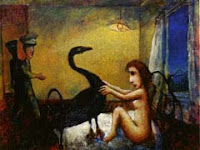Where do Black Swans come from?

Since the released of Nassim Taleb's book "The Black Swan: The Impact of the Highly Improbable" in 2007 during the subprime crisis, the elegant-but-mysterious bird has become the symbolic representation of abnormal dangerous events, deviations from normality or heavy tails.
Since then the Gallina has become more threatening than a whole assembly of market bears - it represents what hits you more because it is the threat you cannot see, you cannot measure, you cannot compute!
All the algorithms and high performance of all modern quant-technology inspired by the wise men like Gauss, Black or Scholes are of no use against the inaccessible powers of the magic bird.
From Black & Scholes to Black Swans
In another era "the BS conditions" were standing for "Black & Scholes" conditions assuming "log-normality" of returns and constant volatility. Now that the monster has appeared "the BS conditions" are likely to take a new signification : the Black Swan conditions announcing a period of highest uncertainties, doubts and fears.
Where do Black Swans come from?
Is it really true that the wise men did not have in mind the existence of abnormal events and abnormal behaviors in the real world? May-be there were things they told us and we forgot to check? Shouldn't we have paid more attention to the disciples of Gauss (1777-1855) and Euler (Bâle 1707, St Petersburg 1783), in particular to the work of their Russian successors : P.L. Tchébychev (1821-1894), A. A. Markov (1856-1922) and A. M. Liapunov (1857-1918).
Claim - Black Swans are generated by the fact that market returns can be, at least temporarily, driven by :
- a group of actors with similar, hence non independent, behaviors (e.g. contagions of positive or negative emotions)
- OR a particular actor with a very strong potential impact (e.g. an investment bank must in a dramatic, even Stendhalian move, must liquidate huge positions over a very short time-horizon)


Comments